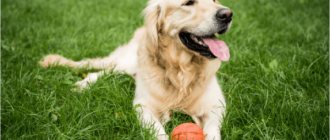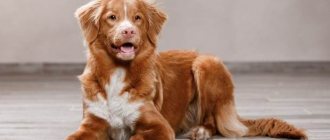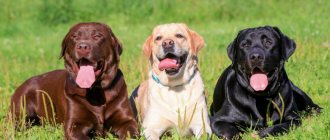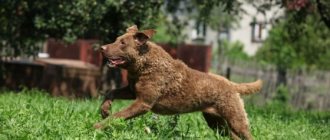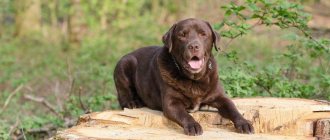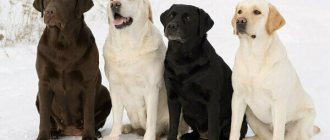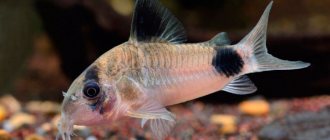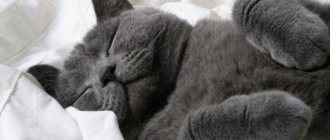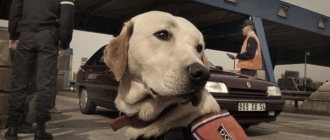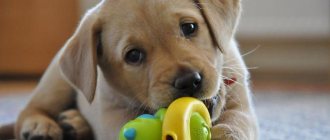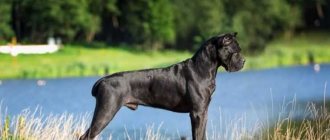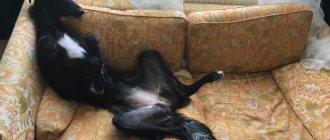Maintenance and nutrition
Golden retrievers are kept in apartments and enclosures - they do not freeze in winter and tolerate frost well. They are not used as guard dogs; the retriever cannot be chained. Representatives of the breed cannot stand prolonged loneliness. You need to devote time to training and walks every day.
5 mandatory procedures
The responsibilities of the owners include carrying out five hygiene procedures.
- Eyes. Periodically wipe your eyes with a damp cotton pad. Their condition is assessed. The discharge of even a small amount of pus is a reason to take your pet to the veterinarian. Be sure to wash your eyes after walking in the forest.
- Teeth. Without care, yellow plaque and tartar form on the teeth. They try to teach puppies to care from an early age. Teeth are brushed regularly with a brush and pet toothpaste.
- Ears. Look into your ears once a week and wipe them with a damp cotton swab.
- Bathing. There is no need for frequent bathing. This is done several times a year and additionally as needed. Use special shampoos that do not cause dry skin.
- Combing. The coat is brushed daily. Show dogs are sometimes cut. It is difficult to do a natural haircut on your own; owners often turn to grooming specialists.
The Golden Retriever does not choose one owner. He is equally friendly towards all family members - adults and children.
Natural diet
Make up a balanced diet - include meat, fish, cottage cheese, eggs, cereals and vegetables. An approximate menu for a retriever of any age is given in the table.
Table - Retriever Menu
| Products | Recommended | Prohibited | Share in daily diet |
| Meat | - Beef; - turkey; - chickens; - rabbit meat; - boiled offal | - Pork; - mutton; - smoked meats; - sausages | 50% |
| Cereals | - Rice; - buckwheat; - millet | — Barley; - corn; - semolina | 25% |
| Vegetables | - Carrot; - cabbage; - beet; - turnip; - pumpkin | — Citruses; - grape; - rhubarb; - spinach; – exotic vegetables and fruits | 25% |
| Dairy | - Cottage cheese; - kefir; — ryazhenka | — fermented baked milk — Whole milk; - cream; - yoghurts with flavors and fillings | |
| Fish | Low-fat sea varieties | Fatty sea and river |
Many representatives of the breed have an excessive appetite. The daily food intake is strictly divided into several meals and given in small portions.
Dry food
Until four to five months, retrievers are fed specialized food for large breed puppies. Then they are gradually transferred to adult food. Natural food is not included in the diet. Choose premium or super-premium food for large breeds. They contain a sufficient amount of minerals that support healthy joints.
Retrievers are prone to allergies, including to low-quality, cheap food. An allergic reaction is manifested by changes in the color of fur and skin, itching. Feed is selected carefully, introducing it into the diet in small portions. Preference is given to types based on lamb meat.
Until the age of five months, puppies are fed four to six times a day. The daily amount of food is divided into small portions. Gradually reduce the frequency of feedings. By eight months of age, they are fed twice a day. Before the change of milk teeth, the puppy is given yogurt, cottage cheese, and kefir daily.
Retriever Care
It is recommended to separate retriever puppies from their mother no earlier than one month of age, preferably at 1.5-2 months. Together with the puppy, do not forget to get a full consultation from the breeder in terms of caring for the dog: a description of the diseases and character of the parents, whether the puppies are vaccinated, how long ago the helminth race was carried out, what to feed at first, etc. It is advisable to take a small object from the puppy’s mother, for example, cut off a piece of cloth on which the babies grew up and slept. It will be easier for your golden baby to get used to the new environment.
Retrievers require constant care. Proper care of a golden retriever involves an integrated approach:
- The dog's diet is tailored to its age. As a rule, dogs prefer high-calorie and concentrated food.
- Wool: The breed is famous for its not too long coat, which does not require special care. It is enough to brush your dog daily with a special iron brush purchased at a pet store.
- The Golden Retriever dog's skin is inspected daily for ticks and other parasites.
- You should bathe only when necessary, no more than 1-2 times a month.
- It is recommended to trim the nails of golden retrievers regularly if the growths are not sharpened naturally, in order to avoid shifts and damage to the limbs.
- Physical activity: if the retriever lives at home, you will need to create conditions for the dog to have an active lifestyle - walk at least 3 hours a day, make the dog run and jump.
- Veterinary examination: the dog is shown to a veterinarian at least once a year. The doctor will conduct a routine examination, monitor timely vaccinations, and recommend the necessary measures to prevent diseases inherent in dogs of different breeds and ages.
To better understand how to care for your Golden Retriever, consult a professional. Remember, this dog breed requires a lot of attention.
Care and maintenance
The coat of the Labrador Retriever requires special attention and care.
Although it is quite smooth and also waterproof, it is worth paying attention to. Labrador Retrievers need to be brushed once a week
This procedure will remove all dead hair. You also need to bathe your dog, but very often and with a minimal amount of shampoo. Otherwise, it may damage the waterproof layer of wool.
Labrador retriever puppies
Next are the ears. The Labrador has floppy hair, which means that he is more at risk of contracting parasites or infections than other dogs. Ear checks should be done regularly. And you shouldn’t neglect a general examination of the dog. He may have fleas or, even worse, there may be ticks on the dog, and this cannot be delayed.
This breed needs frequent walks. They must spend a lot of time outside and do all kinds of exercise. This way they can develop their muscles and use all their energy. You need to always be on guard with a Labrador. Because of their powerful necks, these dogs often break off the leash or knock over their owner. They don’t do this on purpose, but the situation is not the most pleasant.
A Labrador that lives in a private home should be kept behind a high fence. It often happens that these dogs escape by jumping over the fence. The Labrador is a natural swimmer. If possible, take your dog out to the lake so he can swim to his heart's content. A young puppy needs to be accustomed to water. At first he may be a little scared.
You should not throw your dog into water, even if it has been in the water many times before. The Labrador must enter the water on its own from the shore. This is the only way he will know which way to get back.
Cases have been recorded when even these wonderful swimmers drowned only because they did not know how to get out of the water
So, caring for and maintaining a Labrador Retriever does not require any special knowledge, but you need to pay attention to the dog. Otherwise you may face some problems
How much does a Labrador Retriever cost?
If it is expensive for you to buy a puppy with all the paperwork, then take a closer look at the option of purchasing a Labrador Retriever without certificates through friends. This will be much cheaper, but the risk of deception cannot be ruled out - they may sell you a puppy with poor health or not a purebred, but with a mixed genotype of different breeds.
A puppy with papers and documents will cost 20-35 thousand rubles, it all depends on the region and the status of the kennel. Without papers, dogs are cheaper, sometimes the price reaches several thousand rubles. You have the right to buy such a puppy and enjoy it no less than a baby with a huge pedigree. Unfortunately, in the latter case, you will have to refuse to participate in exhibitions, since the puppy’s appearance will differ from the stated standards. Labradors with a pure pedigree, consisting entirely of champions, will be much more expensive than all the others. Their appearance is the standard of aristocracy; they are ideal noble dogs. Such pets occupy leading places at exhibitions and are popular among famous personalities. Such luxury will cost the buyer from 40 to 60 thousand rubles. I must say that this price for a Labrador is completely justified: you will be proud of your royal dog and catch the admiring glances of others.
Black flat
The Flat-Coated Retriever (Flat) is a hunting dog. His pedigree is a mix of Labrador, spaniel and collie breeds. The Flat differs from its golden counterpart by its straight coat and black color. According to the International Canine Association, there is an approved standard and appearance that all breeders of this dog are guided by.
Dossier
Height of an adult: height of adult males at the withers - from 59 to 61 cm, females - from 57 to 59 cm. Weight: from 25 to 36 kg. Characteristic color: dark chocolate brown or black. Coat length: medium, straight with a characteristic silky sheen. Life expectancy: 10-14 years. Advantages of the breed: intelligent with high working qualities. An excellent companion dog. Difficulties of the breed: affectionate, sensitive, difficult to cope with separation or change of owner. Average price: 90-100 dollars. Classification: medium breed from the group of retrievers, spaniels and water dogs. Refers to hunting.
Theses
The breed was bred in the mid-19th century to solve specific hunting problems.
A distinctive feature of the breed is its color; dogs can be liver or black in color.
They perform well on the hunt and are valued by real hunters. But they are not very common as pets in the CIS countries.
Flats have a soft, good-natured, playful character.
They get along well with children, but they are quite large and can inadvertently knock a child down.
Like all hunting breeds, they are very energetic and tireless, long walks are necessary.
Purpose and hunting with a straight-coated retriever (flat)
The Flat-Coated Retriever is endowed with all the qualities and abilities of a gundog. Compared to Goldens or Labradors, he is faster, more maneuverable and resilient. As befits a retriever, he simply loves water and is a very professional swimmer and diver. Smart and attentive, he skillfully scares away a bird within a shot. In addition, his keen sense of smell and resourcefulness allow him to quickly find game on land and in water. Adapts quickly to changing circumstances and will work equally well with owner, trainer or guest.
The Flat-Coated Retriever is a tireless, passionate hunter, an unsurpassed fetcher and tracker who is always ready to work.
It is worth noting that in terms of hunting use, flats are more versatile than other retrievers. They easily learn to work by following the blood trail, try to be the first everywhere and always, but their main quality is complete solubility in the owner. Flat is multi-talented and can be an athlete or a service dog. The most suitable disciplines for obedience and agility: agility, obedience, flyball, dancing with dogs. In service dog breeding, the work of a search dog or a guide dog suits him.
Advantages and disadvantages
A versatile, intelligent working dog with many talents, stable, sociable, friendly to everyone at home. The straight-haired is considered the most active among other retrievers, agile, intelligent, with lightning-fast reactions.
These active, hard-working animals constantly need something to do. They are ready to hunt, search or play something constantly. The Flat-Coated Retriever remains a good-natured, gentle, cheerful dog until old age. They are usually very friendly, so using fletts as guards will not work.
According to reviews from owners of straight-coated retrievers, this breed has virtually no disadvantages. Character – easy to train, affectionate, loyal. The appearance is balanced - elegant and powerful at the same time. The only negative is that sometimes there are “too many” pets. A lively temperament constantly forces the dog to look for more and more new adventures.
Characteristic behavior
The character of golden retrievers is calm and balanced. They are distinguished by good nature, intelligent manners, and confident behavior. They have an easygoing disposition, are playful and energetic. They are naturally efficient and hardy. They are not afraid of water and love to swim.
Learning ability
They have a good memory and well-developed intellect. They are inquisitive, obedient, and easily learn commands. Moreover, they are very helpful; The pet can be taught to help with household chores, for example, fetching various items. According to research by American psychology professor Stanley Coren, Goldens rank 4th among 133 breeds in terms of intelligence.
Attitude towards the owner, children, strangers
Representatives of the breed are highly socialized and constantly need the company of people. They don’t choose the owner; they love everyone who treats them well. They are ready to follow a person everywhere and love spending time together. With their presence, goldens bring joy and relieve stress. They subtly feel the emotions of other people and transmit positive energy to a person.
They are not aggressive, they adore children and can become real nannies. Thanks to their stable psyche, they meekly endure the “bullying” of children without causing harm. Dog experts say that Goldens are safe for children.
They do not show wariness or aggression towards strangers, so these dogs cannot be used as guards or watchmen. However, by upbringing you can ensure that your pet does not approach strangers on the street.
Attitude towards other pets
They are always friendly towards other animals and are not prone to dominance. With proper upbringing, they find a common language with cats, rabbits, etc. They live amicably with other dogs in the house. Having met their relatives on the street, they try in every possible way to avoid conflicts, they are never the first to attack, but they are quite capable of standing up for themselves.
Training
One of the best qualities of a Golden Retriever is their understanding of their owner and their tendency to learn, which is why they are so trainable. Only a good-natured attitude on the part of the owner will facilitate learning, because Golden Retrievers are much more vulnerable than their fellow Labradors, which, according to the description of the breed, have many common characteristics.
You can begin your first attempts at training as early as a puppy. To stimulate the hunting instinct, you can tie a cloth in a knot and move it in front of your nose or along the ground - this will allow your pet to grab the object with its teeth. With age, instead of a rag, you can switch to toys. Puppies can also be trained using throws - this must be done slowly so that the dog can follow the movements of the hand.
By the age of 10 months, a Golden Retriever should learn to swim and dive. If it is not possible to train the animal on your own, it is better to send it to a trusted school, where in a short period of time the pet will learn the listed commands.
Origin of the breed
The name of the breed, Golden Retriever (retrieve), is translated as “a dog that serves game,” and the prefix “golden,” as you might guess, means a luxurious shade of coat.
Golden retrievers were bred in Great Britain, with most of them living in Scotland. In those days, special dogs were required to find shot game. There is a legend that Lord Tweedmouth was involved in breeding the breed.
For more than half a century, he carried out breeding work, selecting the best representatives of hunting breeds - setters, water spaniels, Labradors and retrievers themselves. This is how golden retrievers were born, replacing their smooth-haired relatives.
Later, the breed began to be crossed with the bloodhound, due to which the hunting qualities of golden retrievers improved, in particular, the sense of smell became more sensitive, and the body became voluminous and powerful. The dogs received official recognition in 1913. The first golden retriever was brought to the USSR from the USA in 1989.
Characteristics and description of the breed
The popularity of golden retrievers is increasing year by year. More than 70 thousand of these dogs are registered every year in American clubs alone. The love for these animals is caused by their character - they are kind, well-mannered and playful, so any family will simply be delighted with them.
Aggressiveness
Depending on what kind of dog a Golden Retriever sees next to him, he may behave differently. This breed reacts as follows:
- when near small dogs, retrievers try not to approach them first, since they are not interested in them;
- They are wary of larger dogs and first look closely before starting communication.
Activity
Golden Retrievers are very active dogs. They can spend the whole day on the move, practically without stopping. They can always find something to do that suits their rhythm, but most of all they love it when their owner devotes his time to them.
Training
No matter how smart a dog is, it still needs training. With golden retrievers, training will be much faster than with other breeds, as these pets pick up everything on the fly.
Shedding
Many owners of golden retrievers claim that these dogs can shed heavily only in the spring, when the warming winter “coat” becomes a burden.
In bitches, shedding directly depends on the cycle, so they should pay special attention
Need for care
The Golden Retriever is a breed of dog that is simply not capable of living in a kennel; it is more accustomed to an apartment environment. For this reason, before purchasing a puppy, you need to understand how much time you can devote to it. Caring for a retriever is quite simple, but before this, the pet needs to be trained to use the tray from childhood. Some procedures must be carried out regularly, once a month or a week.
Friendliness and attitude towards children
It’s not for nothing that Golden Retrievers are called babysitters, because they love to spend time next to small children. Not only are they friendly and affectionate with them, but they can also calm them down if they sense that the children are worried about something. Retrievers often offer to play to distract the kids.
Health
Despite the fact that the retriever has innate instincts and hunting abilities, nature has not endowed it with good health. They are genetically predisposed to various types of diseases:
- obesity (you cannot overfeed these dogs, as they can gain a lot of excess weight in a short period of time);
- oncology;
- hip dysplasia, in which the dog feels constant pain and may limp;
- cataracts and entropion;
- skin diseases;
- cardiovascular diseases.
Attitude towards loneliness
It is not a good idea to leave golden retrievers alone in an empty apartment or house for a long time, as they may get bored. This breed can tolerate a few hours without their owner, but being alone all day will be an impossible task for them.
Maintenance cost
The initial expenses will be the largest and will range from 5 to 10 thousand rubles. This price includes bowls, toys, vaccinations, food and other necessary items for your pet. In subsequent months, expenses will be about 2.5-3 thousand.
Intelligence
Golden Retrievers are intelligent and intelligent dogs, which is why they are so trainable. According to Stanley Coren, this breed ranks fourth in the list of the most developed dogs.
Noise
Despite their activity, golden retrievers are characterized by silence and patience. They don’t make a fuss over any little thing and don’t annoy you with causeless loud barking.
Health
The average lifespan of a Golden Retriever is 11-12 years. They may suffer from specific diseases, so it is advisable to take them to the vet once a year. Among these diseases, hip dysplasia and obesity are common.
Dysplasia occurs in a quarter of dogs and this is in Europe, where most puppies undergo genetic testing. Eye diseases are also common, especially cataracts and glaucoma.
In 1998, the Golden Retriever Club of America conducted a study which found that 61.4% of dogs died from cancer. In 2004, the English Kennel Club examined and reduced the figure to 38.8%.
They may also suffer from diseases of the cardiovascular system, especially cardiomyopathy. In addition to the fact that they shed a lot, they can also suffer from various skin problems, among which allergies are the leading one.
What does a Golden Retriever look like? Description of the breed with photos and videos
To better learn about the characteristics of this species, it is recommended to carefully study the description of the modern Golden Retriever breed. This includes adult size and weight, coat color and type, and possible varieties.
Size and weight
The height and weight of a representative is determined by genetic predisposition, so do not despair if, according to the parameters, the golden retriever “does not reach” the norm or, on the contrary, exceeds it. Some puppies grow quickly, others grow slowly, the main condition is the good physical condition of the dog and his health.
A Golden Retriever is born weighing up to 3 kg, its height at the withers is about 20 cm. In the first month, Golden Retriever puppies gain from 400 to 800 grams, and add about 3 cm in height. As they develop, by 6 months their weight individuals range from 24 to 26 kg, height at the withers - up to 55 cm; by 10 months, a golden retriever weighs 30–36 kg, its height is 55–61 cm. The size of an adult dog is characterized by the parameters from the table.
| Bitch | Male | |
| Weight | 25–32 kg | 27–36 kg |
| Height | 50–56 cm | 56–60 cm |
Experts note that pets intended for shows and exhibitions look more voluminous than those considered “working”. From this information we can conclude that female Golden Retrievers are smaller in height and weight than males. Compared to others, the Golden Retriever is considered a large breed.
Color and coat type
Externally, individuals stand out from other species: they are active, playful, and have gorgeous fur and color. Golden's fur
retriever up
It must be straight - pronounced curls are not allowed according to the standard, but slight waves may be present. The undercoat is dense, waterproof, and clearly expressed.
Shedding of the Golden Retriever breed occurs in the autumn and spring seasons.
Do not confuse the Golden Retriever with the Smooth-Coated Retriever - these are two different types that differ in color. The color of the coat includes all shades: from golden to beige and cream.
There may be light hairs on the chest, but shades of red are not allowed - this breed is considered not purebred. The dark golden hue also confirms the standard.
Breed varieties
There are three varieties of the Golden Retriever breed:
- English type. Distributed throughout Australia and Great Britain, it is distinguished by a wide skull, powerful front legs, and the color of this golden retriever is lighter than that of the American type. The height of males is 56–61 cm, and that of females is 51–56 cm. They have a friendly facial expression, a quick-witted character, and a breed with pronounced working traits.
- American type. Characterized by elegance and less muscle development. The American type is easy to recognize - its color is slightly darker than that of the English Golden Retriever. The height of males is 58–61 cm, females – 55–57 cm. To improve the characteristics of the breed, American breeders bring the English type for mating.
- Canadian type. Belongs to a more modern generation of puppies, which is distinguished by a dark coat color. The Canadian variety is a breed combining the English and American types. Males reach a height of 58-63 cm, and females - 55-59 cm, which means that the Canadian Golden Retriever has the tallest height.
Based on these indicators, the golden retriever breed standard is determined, so when purchasing a pet from a breeder, you should pay attention to the parameters so as not to encounter fraud
Personality of a Golden Retriever
Retrievers are considered unique dogs not only based on their excellent hunting abilities. The behavior inherent in animals at home makes it possible for people with small children to purchase pets:
- Smart and diligent in hunting, the pet at the same time becomes a faithful friend to its owners.
- Despite their natural persistence, retrievers are patient and flexible.
- The breed is not an aggressive species.
- Golden dogs are often purchased as a guide and support dog for people with hearing and vision impairments, for service in law enforcement agencies and the Ministry of Emergency Situations.
The dog is obedient in behavior, naturally hard-working and ready to remember commands. Despite the positive characteristics of the Golden Retriever breed, if the pet is not given due attention, the dog is capable of hissing and whining in protest for a long period.
The following behavioral traits are characteristic of a dog:
- Energy and endurance;
- Hunting sense;
- Good memory, developed intelligence;
- No fear of water – retrievers love to swim;
- Readiness for obedience and service.
Due to their personality traits, retrievers are often used as service dogs, border dogs, and trained to detect drugs or explosives. Dogs make good rescuers. When interacting with children and family, retrievers show amazing playfulness and affection. A good-natured, big guy is unlikely to make a watchman.
It is difficult to induce in a dog a feeling of hatred towards people, rather the opposite. Golden Retrievers are willing to obey. They demonstrate the qualities of nanny dogs; in Europe they even use retrievers in special therapy. For older people, the breed will be a good choice in terms of companionship. Therapy dogs, as doctors have dubbed golden retrievers, save lives—communication and spending time in canine company speeds up the mental recovery of even hopeless patients.
Retrievers are always friendly towards other animals and will not attack first. They love to swim, which sometimes becomes a difficulty for the owner: a dog, let off a leash, is capable of rushing into a pond after ducks or after someone else’s abandoned toy. Mostly, golden retrievers are ready to obey and guess the owner’s wishes. Dogs are easy to teach the simplest commands, which is why they are often used as movie actors and advertising dogs.
Varieties
The Golden Retriever is a recognizable breed with distinct characteristics. Dog handlers distinguish three types of such dogs.
- American. It is distinguished by its rather bright color and greater height. There is no light or dark color.
- European. The coat color is light, sometimes close to white. They are distinguished by their massiveness - wide chest, muzzle, shortened, muscular legs.
- Canadian. They are an intermediate link between the two types described above.
All types have external differences, but have the same character. Golden retrievers are friendly, get along well with other pets, love children, and are devoted to their owner.
Differences from Labrador
The Labrador is a separate breed, but it was used in the development of Golden Retrievers. Therefore, dogs are similar in a number of criteria. For example, they are hunting, intended for searching and bringing shot game to the owner. They are friendly, do not enter into conflicts, and are not prone to aggression. They have an excellent sense of smell and can be used as search dogs. The distinctive features of the two breeds are reflected in the table.
Table - Similarities and differences between the Labrador and Golden Retriever breeds
| Parameter | Labrador | Golden Retriever |
| Wool | - Short; - tough | - Soft; - long; - golden |
| Tail | Raised | Lowered |
| Character | — Simple-minded; - tactless; - emotional | - Aristocratic; - calm; - rational |
Nutrition
When purchasing golden retriever puppies, it is important to ask what their diet was like at the kennel or with the previous owner. Ideally, at least three months should pass from birth before entering a new family.
Golden retriever puppies
At this time, the dog eats its mother's milk. But if this is not the case, then we need a worthy alternative. If the breeder is competent and conscientious, he will give future owners instructions on food intake. As for the retriever himself, he is tolerant of any food. But this does not mean at all that you need to feed him anything. In order for the retriever's coat to always remain beautiful and shiny, he will need calcium and other trace elements.
If the owner chooses premium dry food, then the question of taking additional vitamins will not arise, since the necessary components are already included in the factory diet. But if we are talking about natural food, then additives will be required in the bowl.
At least a third of an adult dog’s diet consists of proteins - turkey, chicken and beef, as well as sea fish once a week and cottage cheese
At the same time, it is important to remove excess fat from meat products, and also skin from poultry.
This is how golden retrievers ask to eat
The remaining proportions are approximately equally divided between complex carbohydrates such as buckwheat and rice and fiber. Acceptable vegetables include carrots, beets, cabbage, pumpkin, turnips and greens. They are grated and either served raw or stewed.
By the way, this breed is tolerant to milk, but only up to 6 months - the period while teeth change. This product can be given in its pure form or cereals can be cooked with it. And to ease the pain when teething, special store-bought bones, or cartilage and sinews are suitable.
If the owner prefers dry dog food, then it should be remembered that the Golden Retriever dog is prone to allergies. Therefore, frankly cheap products will not only not be suitable, but will even harm the dog.
Features of care and maintenance of the breed
The Kuvasz's long, special-structured coat mats or rolls up when kept naturally, and the dog looks somewhat disheveled. Hungarian peasants do not consider it necessary to comb it, since the thick coat protects the animal’s skin from injuries, cuts and scratches. In addition, blood-sucking insects do not penetrate through tangles and tangled strands.
But for a show dog, as well as a pet that lives freely on a vast country plot, special care is needed. A combed Kuvasz looks very elegant, reminiscent of a large golden retriever. You need to get used to brushing from puppyhood, devoting a few minutes a day to it. An adult dog is brushed once every two to three days.
There is no need to bathe the Hungarian Kuvasz; this procedure is carried out only before the exhibition, and shampoo for coarse wool is used for washing. The outer coat of the Kuvasz has the ability to repel dirt and is self-cleaning. Even if the dog gets heavily muddied during a walk, by the morning he will be absolutely clean, since dirt particles are not retained on the hard guard coat.
Education and training
The Golden Retriever adapts to conditions very easily and quickly and undergoes training. He is a smart, obedient and talented pet for whom it is extremely important to earn the trust of his beloved owners.
Before you begin complex training, we advise you to lay the foundation, so to speak. To begin with, teach the animal to relieve itself only on the street (especially important for goldens living in an apartment).
Then be sure to check that it does not cause damage to household items. Otherwise, stop the dog and start reprimanding him. By the way, the only method of punishing a domestic dog is verbal.
Accustom your retriever puppy to a leash at 2-3 months. He should walk next to you without struggling. You should practice doing this every day. Only take him outside the house if he has learned not to pull the leash forward.
At 4 months, your Golden should already know at least 5 commands, including “sit” and “voice.” It is better to train them in the first half of the day, when the dog is most active. Always reward him for successfully following commands with a treat.
